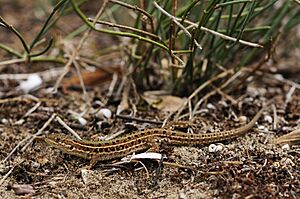Balkan wall lizard facts for kids
Quick facts for kids Podarcis tauricus |
|
|---|---|
 |
|
| Conservation status | |
| Scientific classification | |
| Synonyms | |
|
The Podarcis tauricus, also called the Balkan wall lizard, is a very common lizard. It is part of the Lacertidae family. You can find these lizards in southeastern Europe and Asia Minor. They live on the ground in many open places. These include grassy areas, olive farms, and even gardens.
Contents
What Does It Look Like?
The Balkan wall lizard is a small, strong lizard. It can grow to about 8 centimeters (3 inches) long. Its tail is usually twice as long as its body. It looks a bit like a small green lizard.
In spring, these lizards are a bright green color. As summer comes, their color changes. They become more olive-green or olive-brown. They often have two thin, light-colored stripes on their sides. The middle of their back might be brownish with black spots.
Their bellies are usually white. But during mating season, male lizards change color. Their bellies turn yellow, orange, or red. Their throats also become green.
Where Do They Live?
Balkan wall lizards live in many countries. You can find them in parts of Ukraine and the Crimea Peninsula. They also live in eastern and southern Romania. Other places include southeastern Hungary, North Macedonia, and Bulgaria.
They are common in mainland Greece and some Greek islands. These include the Ionian Islands and Thassos. You can also spot them in western Turkey. This includes Thrace and northwestern Anatolia. They are found in Albania and southern Moldova too. Sometimes, they are even seen in the southeastern Czech Republic.
Home Sweet Home
Balkan wall lizards love open, sunny places. They mostly live on the ground. You can find them in grasslands, like steppes and meadows. They also like the edges of fields.
They live in olive groves and traditional farms. Rural gardens are another favorite spot. They can even be found in sand dunes with a few plants. Sometimes, they live in areas with light bushes.
Female lizards lay eggs twice a year. Each time, they lay between two and ten eggs.
Different Kinds of Balkan Wall Lizards
Scientists recognize two main types, or subspecies, of the Balkan wall lizard:
- Podarcis tauricus tauricus
- Podarcis tauricus thasopulae
Are They Safe?
The Balkan wall lizard is doing very well. The International Union for Conservation of Nature says it is of "least concern". This means there are lots of these lizards. They are common wherever they can find a good home.


